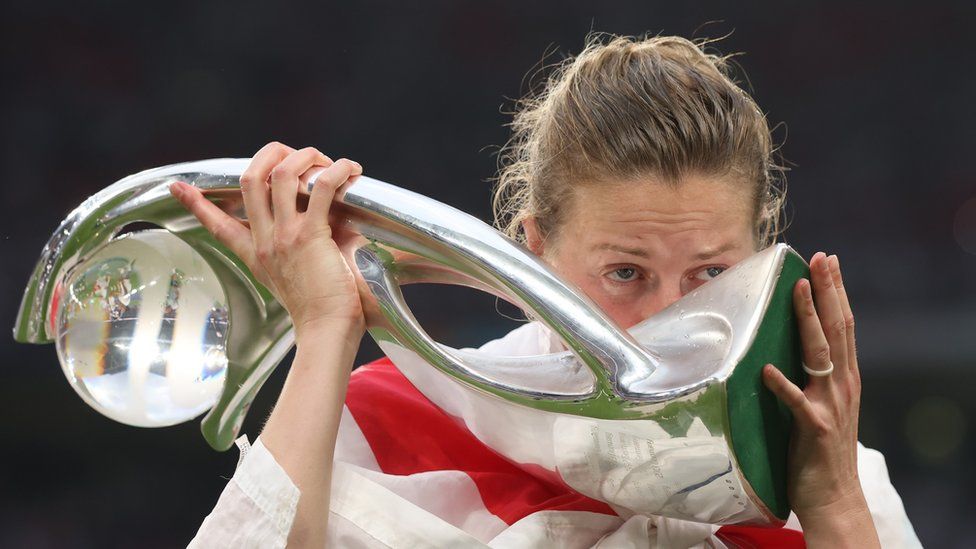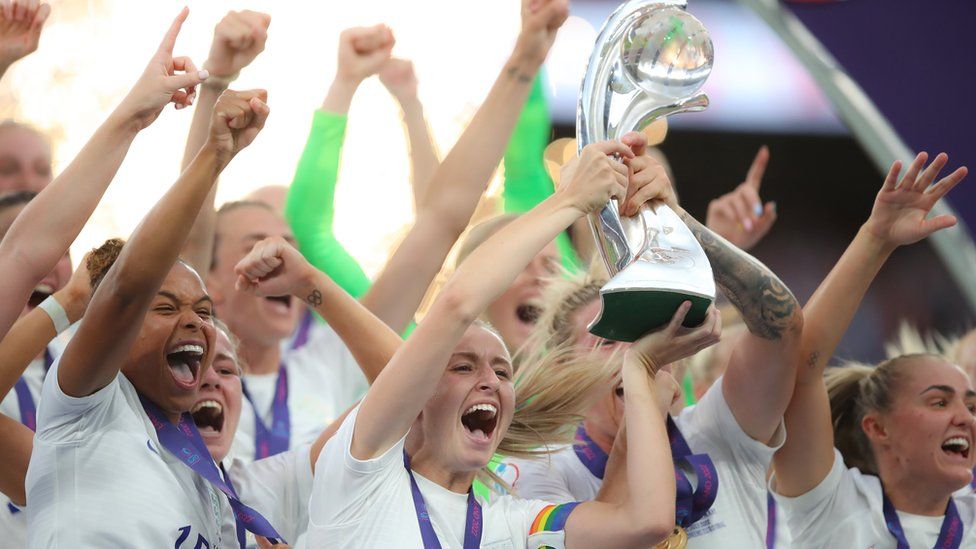England Lionesses captain Leah Williamson is reported to have earned £200,000 last season.
That may be almost eight times as high as the average UK salary, yet compared to the men’s England captain Harry Kane, it pales into insignificance.
On Sunday night, Williamson led the national team to victory in the Euro 2022 championship. But Kane earns the same amount of money Williamson earns in a year in just one week.
He isn’t even the highest paid Premier League footballer: that’s reckoned to be Manchester United star Cristiano Ronaldo who’s reported to be on £400,000 a week.
But following England’s historic win against Germany, which has shone a spotlight on women’s football, could that gap begin to close?
It is a wide gulf to bridge.
According to BBC analysis, the average Women’s Super League player earns £47,000 a year, compared to the millions earned by a Premier League male player at one of the top clubs.
That’s based on available published results from seven of the 12 teams in the women’s league for the salary bill for players and associated staff including managers, and data published by Deloitte relating to nine of the 20 men’s teams.
There’s one consolation: England players male or female are paid the same £2,000 match fee per game and have been since 2020.

But while the Lionesses have been reported to be earning a £55,000 bonus per player for winning the tournament, that £1.3m handout is much lower than the reported £5m that England’s men would have received if they had won last summer’s Euros.
Why is there such a huge discrepancy?
You need to follow the money to find out.
The amount of money clubs bring in is the key factor in governing how much they can pay players.
Take the example of Manchester City. The men’s team is current Premier League Champions and reported £571m in turnover for the 2020-21 season.
The club spent 62% of that revenue on players’ wages, according to Deloitte, which works out as £354m.

With a squad of 30, that equals an average £11.8m per player.
Compare that to Manchester City’s Women’s Super League team.
Its accounts reveal £2.9m in turnover for 2020-21 while its wage bill is reported at £3.3m.
That works out across its 44-strong squad and staff as an average of around £75,000 per player per year.
Where does the money come from?
Football clubs generate funds three different ways: ticket sales, broadcast rights and commercial deals, such as sponsorship.
Analysing statistics published by Deloitte, in the men’s game, ticket sales roughly account for 15% of income with the remaining 85% split between TV fees and sponsorship.
Average attendance for Premier League games is 39,000, while at Women’s Super League matches, average audiences for the most recent season reached 1,931 according to the Football Association.
So even looking at ticket income there’s a huge disparity.
Add to that the fact that tickets for men’s matches are much more expensive than women’s games. If you’re an adult looking to buy a ticket to watch Chelsea in the Premier League, you’ll need to be prepared to stump up at least £65.
To watch the women’s team you can buy a standing ticket for just £9. Even at that low price, tickets seldom sell-out while men’s games are normally sold out weeks in advance.
Precise details of sponsorships are harder to find out, as clubs normally do bundled deals for both men’s and women’s team.
But it’s a certainty that sponsors are mainly paying to be on the men’s shirts.
When it comes to TV, the Premier League attracts an estimated £10bn from a range of broadcasters, including substantial overseas earnings.
In comparison, the Women’s Super League is currently part way through a UK TV deal worth just £8m a year.
The figures are stark but partly based on the relative youth of the professional women’s game. England’s Women’s Super League was established in 2011 and only went fully professional in 2018.
The Lionesses’ success and popularity should mean the next TV and sponsorship deals are negotiated upwards.
As to attendances at games, the Football Association has set a target to reach average attendances at games of 6,000 by 2024, which certainly looks achievable.
More fans will mean more money and that in turn will lead to higher wages for players.
Will Sunday’s win make a difference?
It is set to make a huge difference.
Euro 2022 marked the first time that sponsorship was offered just for the women’s tournament, rather than simply being bundled with the men’s tournament as in the past.
Analysts at Nielsen Sports estimate that attracting big names such as Visa, Heineken, Lego and Pepsi helped increase organiser UEFA’s revenue stream by £25-£33m per year.
That should just be the beginning.
The Lionesses’ success should help wages to rise closer to the likes of European giants Lyon or the US National Women’s Soccer League where top players are handed more than £420,000 per season.
But there’s also likely to be greater investment at grass roots level.
In the last decade some £50m National Lottery money has been invested in women’s football. During the Euros a further £2m was allocated for a new grassroots girls’ programme this summer.

But there’s one telling fact from Sunday’s triumph: the 87,192 crowd smashed the record for attendance at a Euro match, men’s or women’s.
That appears to tell its own story of how women’s football has captured the hearts of fans.
But it’s worth bearing in mind that tickets for the final started at just £15. Tickets for last years men’s Euro final started at £250 with the number of tickets sold limited to two-thirds of capacity by then Covid-rules.
So despite the Lionesses’ success the women’s game is still some way off at bringing in the financial rewards that the men’s game attracts.






